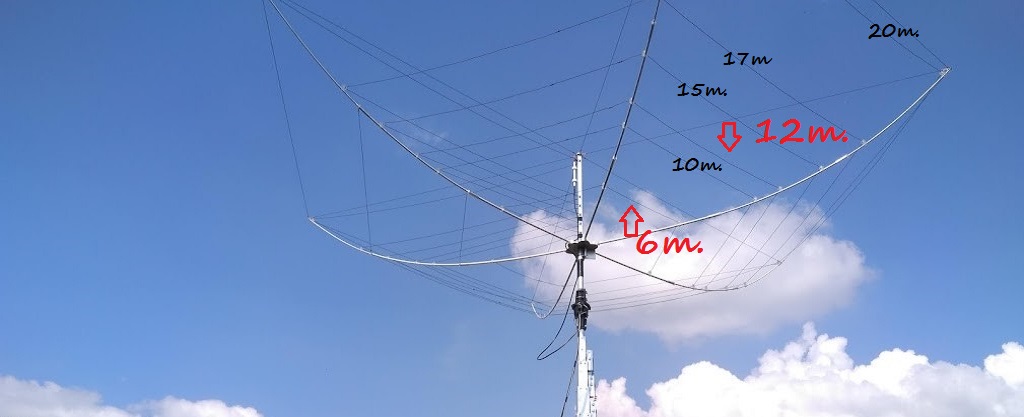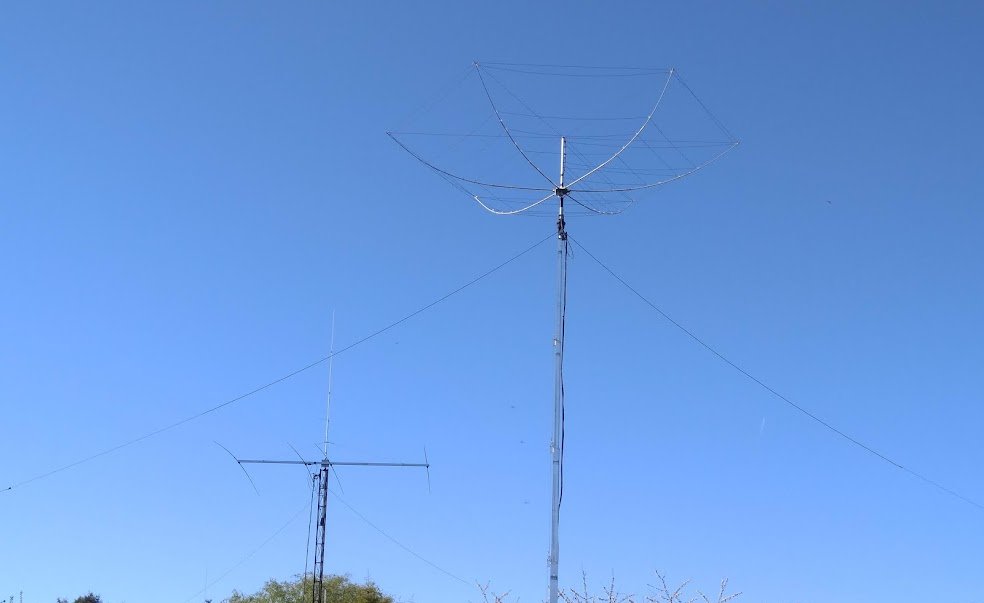My HF Antennes
-
Optibeam OB4-20OWA -monoband 4-element for 20m. -
Hexbeam 10-15-17-20m. band -
1/4wave vert. monoband for 40m. -
Double Bazooka Inverted V for 40m. North / South. -
Two Element Phased Vertical Array for 40m.to the East / West.
SWR measured : Optibeam 4 element for 20m.band / Inverted V - Double Bazooka for 40m.band. Click on picture to enlarge
Hexbeam 10-15-17-20m.band

wire is to close to the 10m.wire.We have modified the Hexbeam –
we downgrade it from a 6-bands to a 4-bands antenne , but I think with a better performance then before.
On the photos you can see the 12m. and 6m. wires that we have removed !
Why we put off 12m. ???
- monoband performances are all very similar, as would be expected;
- the 20m performance is relatively immune to the addition of other bands;
- the 17m, 15m, 12m and 10m band performance, particularly the F/B ratio, suffers to varying degrees from the addition of other bands. The general trend is that the bands closest (in distance and in frequency) have the greatest effect;
- the Broadband Hexbeam Gain is generally affected less than the Classic Hexbeam Gain;
- the biggest performance degradation occurs at 10m when 12m elements are added to the structure.
It is not surprising that there is significant interaction between the 10m and 12m band elements. The “dished” structure typical of most Hexbeams means that the wires for these bands may only be separated by a couple of inches. Modelling shows that if you cannot achieve the 4″ separation between the 10m and 12m wires assumed in these data, the performance will degrade dramatically. The modelling also shows that it is separation at the centre post (where element currents are highest) that matters most; so simply dropping the 10m feedpoint is an easy solution, even though it may result in “sloping” wires. We also saw on the Broadband Hexbeam – In depth page that moderately larger End Spacing does not compromise the performance of the new design, so increasing the End Spacing on a Broadband Hexbeam to allow the 12m wires to be mounted higher in the support structure could be an option.
1/4 Vertical- 40m.monoband for 7mhz groundmounted with Top-radials for reduce antenne hight. One man job to put this antenne down , easy to do ! just put out the screw inside the alu.profile and you can lower the antenna down.
2 Phased Verticals Array for 40m.band ,home made from Two Verticals.Double Bazooka´s! Relais Box (Outside)on the hardwood pawl,for East and West - two Directions -using The Christman feed system is perhaps commonly known as using a pair of 84 degree lines and one 71 degree line connected together to achieve a 90 degree phase shift with a pair of verticals spaced 1/4 wavelength apart. This produces a directional pattern with a good F/B ratio.
-
Home made (old Yaesu 250) Switch for two Directions WEST / EAST. -
Home made Antenne Tuner for Phased Array . -
Home made Switch for Tuner and Bypass . -
Two elevated radials !
Elevated Mounting:
If you elevate radials even a few inches off the ground the capacitive losses go down dramatically. On
80m, 5 feet is all you need to get a drastic reduction in losses, thus allowing the use of fewer radials. Once
the antenna is elevated it is much easier to get reasonable performance with even one .25 wl radial! With
one radial the antenna is no longer omnidirectional, the side with no radial is down by 4 dB, that energy
now appears at high elevation angles on the radial side and can be advantageous for close in contacts (0
to 400 miles).
Once you elevate a vertical, two .25 wl radials work very well. It is important that you try to keep a 180°
angle between the two (opposed, directly in line) for the best pattern. You will need two .25 wl radials for
each band you intend to use. Spread the radials out as far as possible to reduce interaction, if they are
less than a foot apart it can be difficult to get a good match on all bands.
Making the Two Vertical Bazooka Antennas
The 2 beautifule little boxes with the PL259 connector,and on the next Photos you see the antennas are ready to go! Finished.
In Summer time we need to put the elevated radials sometimes away to mowing the grass !
We are using Hardline coax from the shack to the Verticals and then we go over to
coax:H2000 flex on the end , the box and coax you see is buried in the ground.


























